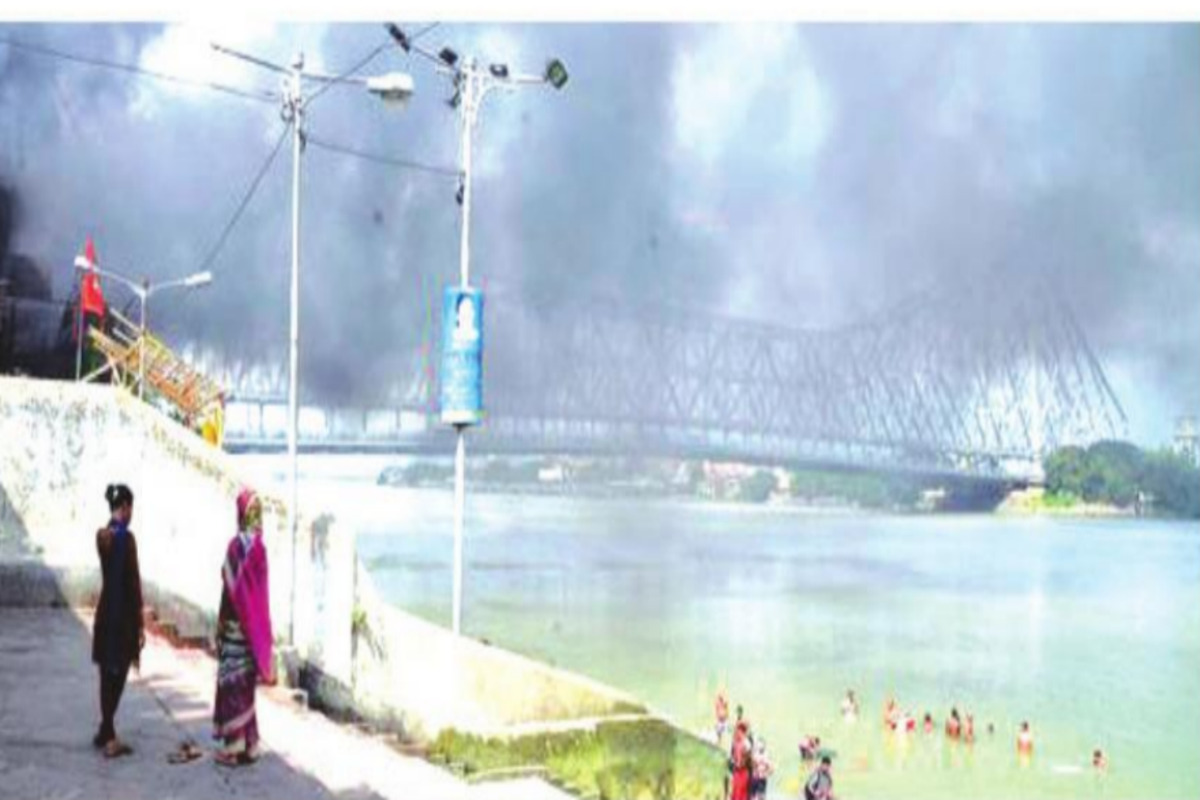During colonial rule, the atmosphere of Calcutta was endangered with artificial impurities. By the 18th cen- tury smoke was cited as one of the health hazards and the major con- tributor to air pollution. The inhabi- tants of Calcutta were ‘forced to breathe a grey brown muck’.
Charcoal, dung, wood etc., used as fuels before the mid-19th century were responsible for the problem of smoke, or miasma. Later, the ready availability of Raniganj coal led to a large increase in coal smoke and a sudden change was witnessed in the atmosphere. The dense black smoke of industrial chimneys raised fears of industrial smoke.
Advertisement
The Calcutta and Howrah Smoke Nuisance Act (1863) passed to abate and prevent nuisances arising from the smoke of furnaces, however, remained almost a dead letter. When Lord Curzon assumed office in India, he was battered with complaints about smoke and despaired that “smoke makes one forget that this is an Asiatic capital”. He also found archaeological structures being soiled and weathered by smoking chimneys and thousands of open-air ovens.
The Smoke Nuisance Act (1905) was passed by Lord Curzon for the abatement of smoke emitted from factories, mills, railways etc., in the towns and suburbs of Calcutta and Howrah. In 1906, the Smoke Nuisance Commission was constituted under section IV of the Act and controlled its working. However, the smoke nui- sance was not mitigated to any appre- ciable extent.
Journals and newspapers expressed grave concern over the problem of smoke. Through the columns of the newspapers, people ventilated their grievances against the mischief caused to public health by the denses column of smoke.
On 11 March 1902, The States- man published the following letter by ‘COMMONSENSE’: “At 6 pm, the hour at which I am writing, the wind, what there is of it, is out of the East, and there is no appearance of smoke com- ing from the directions of the much- maligned smoke-stacks of Howrah; yet I fail to see any appreciable diminution in the density of the smoke blanket which nightly envelops Calcutta…”
In another letter to The States- man (1 September 1902) by ‘A SUF- FERER’, the writer complained of soot that emanated from the chimneys of Tramway Company. The writer com- plained: “I have been recently watch- ing the smoke that issues from the chimney in question when firing up is resorted to and without exaggera- tion; I must say that the nuisance is very pronounced. The other evening for fully 20 minutes it kept pouring out at a steady pace …”
The Swasthya Samachar com- plained of smoke emission from fac- tory chimneys of Calcutta. Describing the smoke nuisance as a ‘serious and urgent problem’, the Indian Medical Record (July 1928) urged to do some- thing without further delay to make the city of Calcutta healthier and free of smoke and grit.
In an article on ‘Smoke Nuisance in Calcutta’ in The Calcutta Munici- pal Gazette, (29 October 1932), the writer described the winter months of Calcutta as “a terror to all citizens”. It was the cause of cold catarrh, throat troubles, pneumonia, asthma and other respiratory troubles.
Through several articles and powerful editorials the Amrita Bazar Patrika (Patrika hereafter) highlight- ed the smoke problem of Calcutta. “In a city like Calcutta, which is the sec- ond largest in the British Empire”, wrote the paper (29 June 1929), the nuisance was “simply enormous”. It continued: “During the winter months, the condition of Calcutta after nightfall becomes alarming. There is much smoke floating near about the ground that one becomes nearly suffocated and those who are not accustomed to live in Calcutta during this season would be glad to fly away to breathe a little fresh air from smoke and soot. In congested area where there are thousands of hearths in the dwelling houses and shops, people cannot see things even at a near distance because of the dense mass of smoke.”
Vendors’ shops, tea shops and other eating houses also discharged smoke at the ground level. “There is so much smoke during the winter in Calcutta” noted the paper, “that even milk-white clothes fresh from washer men get black in a day or two”. Refer- ring to the infant mortality-rate in Calcutta, which was 317 per thou- sand, the paper remarked that “it is staggering to contemplate that more than one-half of the deaths of the babies is caused directly by smoke- nuisance”.
In its editorial of 15 July 1930 on ‘Calcutta’s Smoke Problem’ the Patrika pointed out that dust and smoke found in abundance were the princi- pal causes of respiratory trouble. The paper referred to the alarming report of the ‘Bengal Smoke Nuisance Com- mission’ (1929): “The air we breathe in Calcutta is polluted, stagnant and in some districts for long periods unfit for human consumption.”
The Patrika (May 1932) suggested that the Government Retrenchment Committee should use the pruning knife and save the annual half a lakh rupees wasted on the Smoke Nui- sance Department.
In an article on ‘Domestic Smoke Nuisance and its Prevention’ (Patrika, 4 April 1935), the writer complained of domestic smoke that issued from innumerable kitchens and fire-places for generally two or three hours which pervaded all spaces in Calcutta and irritated and suffocated both man and animal. Thus poisonous domestic smoke was permitted to take a heavy toll of human lives unchecked and unheeded. “Pure air is a heavenly gift”, but owing to smoke and dust it was a rare commodity in a city like Calcutta.
The ‘smoke genie’ was described as a ‘perpetual menace’ to public health by a special correspondent to the Patrika (7 November 1938). “That the general physical tone is lowered as a result of this pollution, is not dif- ficult to visualize”, he noted.
In the ‘Health Supplement’ to the Patrika (5 February 1939) Lt. Col. A.C. Chatterjee, Director of Public Health, described the situation thus: “As the glow in the western sky dies down in the evening, Calcutta becomes covered with a blanket of smoke at night during the winter months and in the spring – particularly in the northern quarters.
The southern side of Calcutta is also covered but to a smaller extent. The smoke becomes dense during those evenings and nights when there is no breeze. At times it is so thick that one cannot see anything on the road about a 100 yards away. The thickness of the smoke is so intense and its effects so impressive that it strikes at once a visitor from outside Calcutta.” Col. Chatterjee noted that ‘throats get irritated on account of inhaling dirty smoke and we get what is now known as Calcutta throat’. He concluded by saying that the “smoke demon is gradually, insidiously but definitely establishing a stranglehold over our health.”
(The writer is a former Associate Professor, Dept. of History, Sivanath Sastri College, Kolkata.)











